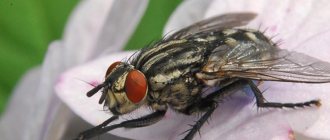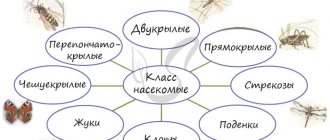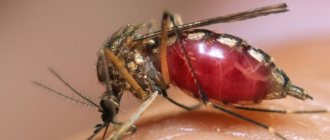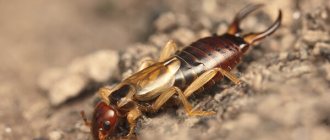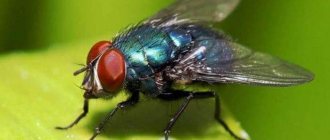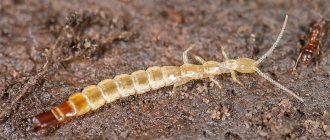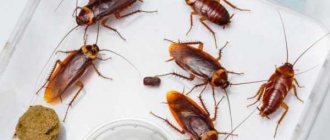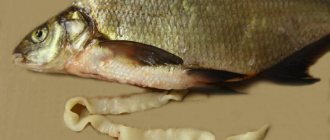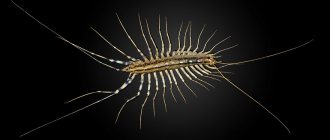Earwigs or double-tailed birds evoke feelings of disgust, disgust and even fear. The insect has an unpleasant appearance - a long body, two sharp swords at the end, protruding mustaches, creating the appearance of a monster, when you look at it you want to immediately leave the room.
But do not be afraid, this creature is not as dangerous as it seems.
The earwig order is a widespread family, representatives of which can be found everywhere - at home, in gardens, vegetable gardens, outbuildings and many other places.
To understand who they are, it is worth carefully considering the appearance, species, habitats, reproductive characteristics and other qualities of insects.
Description
How to distinguish an earwig from other arthropod insects:
- Basically, the length of its body is no more than 2 cm, although there are individual specimens up to 8 cm long.
- The two-tailed bird does not have eyes, and it orients itself in space due to its long whiskers.
- The body consists of separate segments, dark brown shiny.
- As a rule, earwigs can be found under stones, on the banks of water bodies, in the ground, and also in damp forest litter.
- This arthropod feeds on mycelium, small algae, remains of berries and fruits, and also gnaws houseplants.
- Earwig larvae cause a lot of harm to summer residents and gardeners. The larvae mercilessly eat seedlings, root crops, fruits, berries and vegetables. Some species harm the petals of beautiful roses and other flowers.
There are over 1,900 species of Leatheroptera, but only 26 species were recorded in the countries of the former USSR. According to the classification, almost all representatives of the order were initially included in the family of true earwigs, but now there are 490 species and 65 genera. Within Europe there are about 60 species. Among the existing species, the most common names and characteristics of tweezers are noted:
- common or European is distributed in greater numbers virtually throughout the globe. It has a dark red or brown color, in some places even dark brown, and the average size varies from 1 to 2 cm;
- Coastal also predominates almost everywhere in the world under specific soil conditions. The color is similar to sandy or sandy loam soil, that is, sandy gray predominates. The length of the insect is 20-30 mm;
- small is also widespread in every part of the world and differs from other representatives in its smallest size, which is only 4-7 mm. A characteristic feature of this individual is increased activity during the daytime;
- the Asian one has a relatively striking color: the body is black with light yellow spots in the area of the elytra. This species is subject to migration by flights; due to its low speed, the journey can take about two weeks. The size of Asian earwigs reaches 16 mm;
- Central Asian is the complete opposite of Asian, because it has absolutely no wings;
- The Guinea caveman does without sunlight, as it lives in caves. Because of this, she adapted to the conditions: she developed longer antennae and limbs.
The giant earwig was one of the rarest and largest representatives of leatherwings. This species was so rare that it lived only on St. Helena Island and had a limited number. Since the beginning of the 21st century, this insect has been considered extinct, since the last time a living earwig was seen was back in 1967. And even subsequent attempts to discover giants as a result of expeditions were not successful.
Harm and benefits of earwigs
these small insects cause considerable damage to gardens, orchards, and apiaries, feeding on plants, fruits, berries and flower petals (roses and dahlias especially suffer from them). Destroy bees in hives. If there is a large concentration on the site, young seedlings can be completely chewed off.
IMPORTANT!
When fertilizing the soil in the greenhouse with humus, be careful not to introduce earwigs with it, you may lose the entire harvest.
During dry seasons, doubletails cause serious damage to fruit trees, gnawing off the tips of leaves and undermining their roots.
CAREFULLY!
Place baits in places inaccessible to children and animals.
- in case of large-scale invasions of two-east, it is necessary to call the sanitary and epidemiological service.
That's all the information you need about all the advantages and disadvantages of earwigs. The appearance of this insect is quite unpleasant, which may be why there are so many terrible rumors about earwigs.
Here's a video about an earwig invasion:
If you find an error, please select a piece of text and press Ctrl+Enter
.
The earwig (order Earwig - Dermapetra) is an insect that belongs to the order Leatherwings. Often lives in areas where the agricultural industry is well developed. Can cause harm to garden and agricultural crops.
Where does the earwig live?
The insect lives mainly outdoors, preferring damp and cool places: accumulations of withered leaves, compost pits, as well as various crevices and depressions (for example, under fallen trees or stones). The insect is active mainly at night. Less commonly, earwigs are found in residential areas. However, in village or private residential buildings, insects are not such a rare guest.
The earwig is an omnivorous insect. Its diet includes honey, beebread, as well as various garden and vegetable crops. The earwig feeds on both fruits and leaves and stems of plants. All this makes the insect a rather dangerous garden pest. The earwig reproduces by laying eggs; as a rule, the female lays up to 60 eggs. The eggs hatch into larvae that later grow into adult insects. The entire process of transformation from egg to adult occurs within one year. The eggs are laid by the female in late summer or early autumn. The first larvae appear in May-June.
What plants do earwigs damage?
When in high numbers, the earwig causes significant damage to crops, flowers and orchards. Among vegetables, the earwig prefers potatoes, cabbage, cauliflower, chard, celery, lettuce, beets and cucumbers. Earwigs love young plants most and can gnaw seedlings. They also readily consume corn silk, which can result in damage to the cobs.
As for fruits, they damage apple and pear orchards to the greatest extent. In addition, they harm young plum and peach seedlings in early spring by eating flowers and leaves at night, when other food is scarce. Among the ornamental plants they like most are the petals of roses, carnations, dahlias and zinnias. Earwigs can often be found sandwiched among the petals of freshly cut flowers.
Leaves eaten by earwigs become uneven and full of holes. Usually damage can be detected in the morning, since the insect feeds at night. The leaves will be partially eaten. You can also see scattering of earwig excrement in the form of small black balls near the plants. The earwigs themselves can be found under pots or stones during the day.
Damage is often particularly severe during rainy weather, causing earwigs to seek dry shelter and climb onto plant leaves, beginning to feed on them as well.
Earwig damage is very similar in appearance to damage caused by slugs and snails. The main difference is the presence of shiny traces of mucus on the foliage, which means that snails were operating here at night.
Reproduction
The way earwigs reproduce is also surprising. The mating process of insects lasts for several hours. After which, after two months, the fertilized female makes a tunnel up to 8 cm deep, ending in a widening. It is there that she breeds, laying eggs, the number of which varies from 30 to 60 pieces.
The female reliably protects future offspring, both from enemies and from her relatives.
In early March, she lays eggs again; the number of eggs in the clutch does not exceed two dozen. The first larvae can be born at the end of spring, becoming sexually mature by the end of summer. In order to spend the winter, insects crawl into underground burrows, where they hibernate (hibernate).
Structural features
Earwigs are a phylum of arthropods. They have an elongated, flat body covered with hard chitin. It ends with a characteristic forked tail in the form of powerful pincers with serrated teeth. Males can be distinguished by their more curved "pincer" shape. The cerci, as these processes are called, are used during food intake and for defense.
The wings of these insects consist of two parts. The anterior ones are short leathery plates that act as elytra in beetles. The hind ones are very thin and membranous, shaped like a fan or an auricle. Earwigs' wings are unique in that they require the help of the tail to fold them.
Is the person in danger?
Many people are interested in the question: why is the earwig dangerous for humans? Yes, it’s rather unpleasant, especially for squeamish people. The widely known myth that an insect can crawl into the ear, gnaw through the eardrum and eat the brain is just that, a myth. An earwig will crawl into your ear if you sleep in the garden with your ear to the ground. You won’t find it in your bedroom, because the peculiarity of earwigs is their love of high humidity. You can find it in the house in the kitchen, bathroom, toilet, in the garage if it is attached to the house, but not in the bedroom, where it is dry. In addition, an insect bites only in defense; if this suddenly happens, treat the bite site with an antiseptic. The worst thing that can happen is inflammation, but if you treat and disinfect the wound, then this is unlikely.
What does it look like
The body is flat, elongated from 4 to 40 mm, very flexible, the end of the abdomen is pincers (long chitinized processes). Males' ticks are much stronger than those of females. Different representatives of the earwig order usually have different mite sizes from each other. Their function is primarily for defense and use in attack. In a defensive position, the earwig arches strongly and seems to point its pincers forward.
The head is heart-shaped; the oral apparatus is of a chewing type, directed forward; has thread-like antennae; Earwig species differ in the different number of antennal segments, their number ranges from 8 to 50.
The outer cover of the body is a shell, very durable and dense.
A pair of front wings are dense, leathery elytra; wide hind wings – softer in structure, membranous, opening in the shape of a fan.
It got its name thanks to the myth that it supposedly crawls into a house at night and gets into a sleeping person’s ear. But this remains only a myth, since only the search for food can force an insect into the house.
Interesting Facts
Let's consider a number of some interesting information relating to the description of the appearance of the insect, its lifestyle and certain features:
- some individuals reach a length of up to five or even eight centimeters;
- earwigs can produce and secrete foul-smelling substances that can deter predators; Earwigs themselves are considered both predatory and herbivorous:
- they are able to feed on small insects, plants and even moldy fungi, dead rotting materials;
- insects are characterized by a mainly nocturnal lifestyle, they prefer a damp, dark and humid environment, and therefore live under leaves, inside hollow trees, as well as in the cracks of houses, through which they penetrate inside;
- for the winter, earwigs burrow 1-2 meters into the ground;
- at one time the female is able to lay from 3 to 50 eggs;
- female earwigs are recognized as the most caring insects, since they lay eggs in a pre-arranged place, regularly clean it, they feed the cubs with regurgitated food, and if it turns out that the female dies while nursing the offspring, then the cubs immediately eat her;
- Ticks live for about one year.
Video
Tick-borne encephalitis 2020
Hogweed Law 2018
Destruction of bedbugs in Moscow
The earwig is a small, but very frightening insect that is found in all areas of Moscow and the Moscow region. It is often confused with another pest that is very similar to it - two-tailed. The differences between them are often difficult to detect, even looking at static photographs, not to mention a living individual quickly moving somewhere.
- According to the biological classification, the double-tailed bird is included in a different order from the earwig.
- These insects reproduce in different ways.
- They have overlapping but still different dietary preferences.
- The earwig can fly, but the double-tailed bird cannot.
- The forked tails of these insects have a different structure and purpose from each other.
This is not a complete list of insect differences, but it will be very difficult to detect them with the naked eye without special knowledge, and it is not necessary if you do not have a scientific entomological interest. In order to avoid being harmed by earwigs or earwigs, it is enough not to touch the insects with your bare hands. They do not attack people, so they only bite in defense. If you are looking for how to get rid of earwigs, then for this it is also not necessary to distinguish them from two-worts - the methods of destruction for these two insects will be identical.
Distribution area
The insect is native to Europe, East Asia, and North Africa. However, nowadays the earwig can be found even in Antarctica. The development of the geographical range is increasing every day.
Earwig in flowers.
Scientists have even discovered them on islands in the Pacific Ocean. In the Russian Federation, a large number lives in the Urals. In the 20th century it was brought to North America.
The European variety is a terrestrial organism. Shows the greatest activity with minimal fluctuations in daytime temperature.
Habitat
During the day they hide in dark and damp places. They live in forests, agricultural and suburban areas. During the mating season, females live in an environment where there is a lot of nutrients. They lay and bury eggs there. They can live on the stems of flowers.
Sleeping individuals can withstand cool temperatures. They rarely survive in poorly drained soil, such as clay.
Types of earwigs
The true earwig family includes more than 500 species. They live all over the globe and are not found only in Antarctica. Not all types of earwigs are found in the Central region of Russia. The common earwig most often appears in garden plots, houses and apartments. It is this pest that will be discussed here and further. This is a hardy insect, adapted to survive in conditions of sudden climate change several times a year. It overwinters well in the ground under the snow and can live for 2-3 years if it does not die from causes beyond its control.
Despite its scary name, the earwig is no more interested in human ears than any other place to hide. Information that a parasite gets into the ear and gnaws through the eardrums in this case can be classified as a children's horror story, since there are no medical statistics on frequent incidents of this kind. However, theoretically, any insect can get into your ear, so if you have earwigs, you should still take basic precautions and check your bed before getting into it to avoid encountering an insect under the covers.
Diet
The insect consumes a variety of plant and animal substances. Despite the fact that earwigs are omnivores, they are classified as predators and scavengers. They feed on:
- beans;
- beets;
- cabbage;
- cucumber;
- salad;
- peas;
- potatoes;
- celery;
- jealous;
- tomato;
- fruits;
- flowers;
- aphids;
- spiders;
- larvae;
- ticks;
- insect eggs;
- lichen;
- fungi;
- algae;
- apricot;
- peach;
- plum;
- pear.
Natural enemies include ground beetles, beetles, wasps, toads, snakes, and birds. Earwigs are protected with tongs and glands. The glands repel predators with their unpleasant odor.
Earwig: photo
Who is an earwig and what it is best illustrates the description of the animal.
- The insect has an elongated, slightly flattened body, up to 2 centimeters long.
- The color of the back varies depending on the stage of development from light gray to brown and almost black.
- The tail mites of males are slightly curved inward and have serrations; in females they are straight and smooth.
- There is a mustache on the head, equal in length to half the body.
- Looking at the insect from above, you can distinguish folded wings.
To finally make sure that the beetle you discovered is an earwig, look at the photo of the insect and compare it with the pest that caught your eye.
Controlling earwigs in the garden
Prevention The most important part of controlling earwigs is removing their hiding places so that there is not too much plant debris, boards, downed tree trunks, or anything else left in the area that could serve as a hiding place for them.
If earwigs have already taken a fancy to your garden, try the following remedies:
- Place approximately 20cm long pieces of garden hose in the beds between the plants. Check these traps every morning and shake out the earwigs in a bucket of soapy water.
- To protect large plants, apply petroleum jelly to their stems to prevent earwigs from crawling on it.
- If insects have infested your woodpile, try spraying it with a borax solution, but keep pets and children away from the area afterwards.
- Oil pit traps are also an excellent remedy for earwigs. Mix equal parts soy sauce and vegetable oil in a small plastic container and cover with a lid. Punch holes in the top of the container near the lid to allow earwigs to enter. Bury the container in the soil to the level of the holes. The soy sauce will attract the earwigs, but the oil will keep them from getting out. Change the mixture periodically to a new one.
- Alcohol can penetrate the waxy layer of the insect's integument and kill it upon direct contact with the body. To make an insecticidal spray, mix equal parts 70 percent alcohol and water (or, if using 95 percent alcohol, mix 1 part alcohol to 1 ½ parts water).
- Earwigs are also susceptible to diatomaceous earth (diatomaceous earth is available at garden centers), so you can protect your plants by spreading a ring of powder around the bushes if the soil is dry enough. Diatomaceous earth is not effective in wet weather.
Earwig: where does it live?
The life of an earwig always takes place in conditions where the following 4 factors are necessarily combined:
- Dark.
- Damp.
- Warm.
- Secluded.
She looks for them in any place where she appears. In nature you can stumble upon it:
- In the curled leaves of plants
- Closed for the night and withered flowers
- In the fallen leaves
- Under the bark of the trees
- In wood stacks
- Under the stones
- Under folded boards or roofing felt
- In the cracks of the house foundation
Earwigs prefer to build nests and lay eggs in earthen burrows in the upper layers of the soil. There they spend the entire winter, protecting their offspring until spring.
If an earwig has settled in an apartment or house, you need to find out where it lives and whether the nest is located on the territory of the house or whether its appearance is just an accident. In a person’s home, comfortable living conditions for insects are created:
- In cracks in walls and ceilings
- Under the bath
- Under the sink
- In the kitchen
- In damp textiles
- In the cracks in the floor
- Behind baseboards and door jambs
If you see earwigs regularly, then most likely they live in an apartment or house. In this case, it is necessary to urgently take measures to destroy them, before the parasites have time to multiply excessively and fill the entire house.
Coastal earwig (Labidura riparia)
It differs from the common earwig mainly in color and habitat, although it belongs to a different family. Distributed everywhere. As the name suggests, it is found on the banks of water bodies (both fresh and salty), preferring sandy and sandy loam soils.
Coastal earwig, juvenile, possibly nymph (wings not yet formed)
Classification (according to Wikipedia):
- Type: arthropod
- Class: insects
- Order: Leatherwings ( Dermaptera)
- Family: Labiduridae
- Genus: Labidura
- Species: Labidura riparia
The body shape is practically no different from the common earwig. The color is lighter. Juveniles are light brown, blending in with the sand. In adults, black and orange elements appear in the color. The cerci are beige at the base, dark brown at the ends.
Coastal earwig, adult in the folds of a backpack
Personally, I first encountered the coastal earwig on the western coast of Crimea on the Bakal Spit. They accompanied us all evening, ate with us at the same table, some took pasta with them, keeping them in high-raised churches.
I must say, the number and persistence of insects in seeking shelter from the sun amazed me. In the morning, when assembling the camp, it was discovered that entire flocks of coastal earwigs had crowded under all the objects left on the ground, accumulated under the tent, backpacks, and also, if possible, crawled inside the luggage. Subsequently, the lost two-tails periodically suddenly jumped out of things over the course of several days of travel.
Earwigs are predominantly nocturnal insects, hiding during the day in various secluded places (under stones, under fallen leaves, for various purposes, etc.), sometimes gathering in groups of quite significant numbers of individuals. At night they become active, crawling animatedly in search of food. However, few species can be active during the day, for example, the small earwig flies in sunlight, especially often near dung heaps, and the tropical black earwig, according to observations in the Hawaiian Islands, is a very mobile insect that lives in damp places on sugar cane plantations, where she was observed crawling on leaves in search of food during the hottest hours of the day.
Let's look at the structure and lifestyle of an insect using the example of the common earwig.
Earwig: reproduction
The two-tailed bird lays its eggs in the soil and does not monitor their further fate in any way, while the earwig carefully controls reproduction at all stages.
- Earwigs lay eggs in the fall and spring in pre-dug underground burrows in the topsoil.
- Small earwigs hatch from eggs laid at different times of the year at the same time.
- One female lays an average of 40 to 80 eggs per year.
- Throughout the entire period of egg maturation, the earwig takes care of the clutch.
- The eggs are oval, yellow-whitish in color, and almost double in size during the incubation period.
- The larva is a copy of the adult, but smaller in size and gray-transparent in color.
- Over the summer, the larvae turn into adults, ready to reproduce, and literally harden due to the appearance of durable chitinous covers.
Order Leatherwings or earwigs
So, earwigs or leatherwings are a whole order including 1967 species. The front wings are short elytra, under which are folded membranous wings adapted for flight. There are also wingless species of earwigs.
The main characteristic feature is the tail processes (cerci), which form chitinous forceps, which the earwig can use for defense, attack and movement of objects.
Friends!
This is not just an advertisement, but my
personal request
. Please join the ZooBot group on VK. This is pleasant for me and useful for you: there will be a lot there that will not end up on the site in the form of articles.
Well, now about our most common representative of the two-east:
Earwig bite
If we compare the two-tailed earwig and the earwig from the point of view of potential danger to humans, then it is no longer advisable to touch earwigs.
Double-tailed animals have cerci at the end of the body. They look menacing, but are extremely rarely used by insects for defense. If the two-tailed woman has the option of simply running away, she will choose it. Earwigs are much more aggressive in general, especially if they are guarding a clutch. Instead of cerci, they have strong foreps at the back or, more simply, pincers. Because of them, insects are often called mites. With these pincers, the earwig defends itself, like a scorpion with a sting, and holds its prey. With them, it can easily pierce human skin, but only for the purpose of self-defense. These insects are not interested in humans as a food source, so an earwig bite looks like two bleeding dots or a small scratch with jagged edges if you brush the insect off without allowing it to open its tail pincers.
Were you scared as a child by small insects with scary pincers on their abdomen? Such a monster is called differently: tick, pincer, two-tailed or earwig. The last name is the most terrifying. But is the earwig insect really a dangerous creature and is it worth getting rid of?
This is interesting - where else can an earwig go?
I'll start with two terrible revelations. First, the earwig
- this is not the same as
two-tailed
. That is, in our understanding, they are, of course, one and the same, but by turning to Wikipedia we will find that two-tails are completely different tiny creatures that inhabit the soil. However, for the sake of search relevance, I will also have to use the term “two-tailed” to refer to earwigs. The second scary fact about earwigs is that it turns out they can fly. True, they resort to this opportunity extremely rarely, just like, for example, cockroaches (yes, yes, they fly too!).
It is no secret that two-tailed animals cause horror in many people, although, in direct relation to humans, they are completely harmless creatures: they are non-poisonous, do not stink and do not bite. But, for example, yesterday during a photo shoot with an earwig, an elderly neighbor clucked around me so that I would be more careful, because double-tailed earwigs bite very painfully!
The very name “earwig” already inspires horror, and given that most people are afraid of insects as such, the presence of the words “ear” and “twirl” in the name causes not just horror, but panic horror (just imagine...) .
So here it is. Earwigs do not intend to crawl into anyone's ears. However, no one is immune from the discovery of various crawling creatures in their ears, and the risk of this unpleasant event cannot be discounted. If you want horror stories, then read the comments, they are chilling.
In my opinion, it is quite plausible that in some ancient times, in a certain kingdom, in a certain state, where people lived in unsanitary conditions along with fleas, lice and earwigs, cases of two-wests getting into the ears regularly occurred, and the fear of this unpleasant phenomenon As a result, it was embodied in the popular name “earwig”, as if it were already a warning without any additional explanation.
The common earwig becomes helpless when it is grabbed by the cerci
Appearance
Earwigs are small insects, typical representatives of the order Leatheroptera. The body length of adult individuals reaches 1.5 cm. The abdomen of the insect is oblong and colored in brown shades. The ventral part is usually darker than the dorsal part. The head is shaped like a heart, and at its end there are long thin antennae. Ticks have small eyes.
Double-tailed birds have two pairs of wings. The front ones are modified into leathery elytra, which perform a protective function. The wide, membranous hind wings are designed for flight. When at rest, the earwig first folds its membranous wings like an accordion, and then folds them twice to place them under the elytra. The double-tailed bird flies reluctantly, moving mainly with the help of its running limbs.
A distinctive feature of earwigs is a pair of forceps on the abdomen, which are called foriceps. These are modified cerci, that is, posterior antennae, which are found in many insects. In females, the forceps are small, smooth and straight, while in males they are large, serrated and rounded. The forceps are used by earwigs as a means of protecting and holding prey. When the two-tailed bird senses danger, it bends and points its tongs towards the enemy. In this case, the insect closely resembles a scorpion.
Body structure of the common earwig
The body of the common earwig is dirty yellow, in some cases tar-brown. Antennae 13-segmented, 2nd segment rather long and clearly visible, slightly more than half as long as the 3rd, 3rd segment slightly widened towards the apex, cylindrical, the same length as the 5th, 4th segment short , barely longer than its width, about half as long as the 3rd. The head is rusty brown, sometimes almost or completely black, the seams are very sharp, deeply depressed. The fore-back is almost square, with dirty yellow sides. The posterior margin is moderately rounded. The elytra are dirty yellow, sometimes brownish, with a chopped off posterior edge. The wing plates are quite developed. The abdomen of the common earwig is widened in the middle, slightly tapering towards the apex, with dense, coarse punctures. The pincers are quite strongly flattened, their contacting part occupies no more than one quarter of their length, with a jagged inner edge, gradually tapering towards the middle, limiting the inner sides to an almost perfect circle. The rear end of the expanded part is obtuse-angled, the outer side from the base to the apex is slightly curved, or the pincers are more elongated, near the middle they are curved at a very obtuse angle, the outer sides are parallel to each other, the inner ones limit the rhomboidal space.
What does the two-tailed fish eat?
Earwigs are omnivores. Animal food mainly consists of carrion, although two-tailed moths can also attack living victims. Earwigs are dangerous enemies of ticks, aphids and bees. Moreover, the predator eats not only the insects in the hive, but also the honey. The plant food of earwigs is varied. They can eat all terrestrial parts of plants, pollen, algae, lichens, moss and much more.
The gluttony of earwigs has become the main reason for human dislike for them.
The insect can cause serious damage to many cultivated plants - potatoes, tomatoes, cucumbers, beets, cabbage and peas.
Gardeners are also wary of earwigs, as the insect loves to eat the fruits of peach, apple, pear and currant trees. Fortunately, the insect's jaws are not always strong enough to gnaw through thick peels, so earwigs choose either rotten fruit or those damaged by other pests.
Nutrition
Flower petals are a special treat for earwigs. They eat them at night, so it is more convenient to remain unnoticed. Fruits are also included in the diet. True, it is difficult for an earwig to gnaw through the strong skin of a fruit, so it eats what remains from birds, worms, etc. They are very harmful to bee farms, because they sneak into the hives and eat honey and bee bread. Already dead plants and fungi are also used as food.
And yet, the two-oriental cannot be considered an exceptional “vegetarian”. They do not refuse to dine on insect larvae, and even on the insects themselves. For example, they exterminate aphids - they catch them with their back hooks, and then bring them to their mouths, bending strongly.
However, earwigs cannot be called predators; they are not strong for hunting. They are omnivores, but are more likely to be scavengers - rotten vegetation is what they need. Be that as it may, these insects do more harm than good, so it is better to destroy them, and if they sneak into the house, then urgent measures need to be taken.
Reproduction and life cycle
The two-easted fly begins in late summer, after which the fertilized female digs a burrow, which serves as a wintering site and a nest for the ovipositor. At the end of the burrow there is an expanded area in which the female lays oval yellowish eggs in winter. Female earwigs are very caring mothers. They are constantly near the eggs, move them to wetter places and drive them away from the clutches of their relatives. With the onset of spring, the female lays another clutch. The first larvae emerge in May, and the second in June.
The two-tailed insect is an insect with incomplete metamorphosis. The larvae resemble adults in appearance, but differ from them in their smaller size and light body color. Also, the larvae have weakly defined foriceps and wings. The larvae molt 4 times, each time becoming more and more similar to adult insects. After the last molt, which occurs in late July-early August, individuals become fertile.
Prevention of the appearance of the parasite
It is unlikely that you will be able to avoid an encounter with an arthropod insect: the two-tailed insect often ends up home with grapes, vegetables, herbs, where it is easy to hide from the gaze of an inattentive buyer. The country house is also full of secluded corners where the earwig lives. But you can reduce the likelihood of active reproduction in your garden and in your apartment if you follow a few rules.
Recommendations for summer residents and city residents:
when choosing vegetables, fruits, berries, leafy greens, you need to carefully check whether there are arthropod insects among the bunches of grapes or tops; at the dacha you will have to work hard to remove fallen leaves from the area in time so that the earwig has nowhere to hide and feed; When an “uninvited guest” with sharp “swords” on the back of the body appears in the apartment, you need to be more careful about cleanliness, sweep away all the crumbs from the table, and close the jars of water. Leftover food is a tasty morsel for the earwig: you should always remember this; Excessive humidity in the room is the optimal environment for insect reproduction. If the two-tailed bug breeds, it will be difficult to get rid of it
To prevent the appearance of double tails, you cannot “breed” dampness in the apartment; attention to indoor plants is a condition under which the risk of the appearance and reproduction of harmful insects is reduced several times. The more flowers there are in the room, the higher the risk that one or two individuals or larvae will remain among the greenery
Flower growers should regularly inspect leaves, buds, and check the top layer of soil in the flowerpot. The earwig is a larger insect and is easier to detect than other pests (for example, the dangerous spider mite measures no more than 1 mm); tin can trap. Open the container, remove the contents, wash, dry, pour in vegetable oil, place around the apartment. The two-tailed fish will crawl inside, fall into the oil and not get out.
If an adult earwig is found on ornamental plants in an apartment or among garden beds, you need to immediately inspect the remaining plants in order to get rid of the larvae in time and destroy other insects. Traditional methods and chemicals are suitable for processing. The more the bivost has multiplied, the more powerful the drug should be.
Human interaction
As already noted, earwigs can harm crop plants. But it is also important to remember that doubletails eat other pests. So there is some balance.
Earwigs are sometimes called pincers. This is due to the fact that, sensing danger, the insect can pinch a person.
Earwigs are non-venomous and an adult may not even feel the bite.
In sensitive people and children, there may be redness and swelling at the site of the bite. The wound should be treated with an antiseptic, as infection is possible due to scratching the bite site.
There is also a horror story that earwigs can get into a person’s ears and gnaw through the eardrum. However, there is no reliable information that this is actually the case. Two-tailed insects can only get into the ear by accident, like any other insect. This group of insects got its name from its ear-shaped wings.
Ways to fight
If you encounter several earwigs in your home or garden, there is no point in fighting them. But if the number of insects increases rapidly, measures must be taken. Follow these guidelines:
- eliminate excess humidity in rooms and in the garden;
- regularly collect and remove garbage, burn fallen leaves;
- loosen the soil;
- in the house, seal all cracks through which insects can get inside;
- use repellents - vinegar, garlic, tansy, wormwood;
- You can use boric acid by scattering it over the beds, in the pots of indoor plants and in the corners of the house;
- Use traps in the garden. Place wet rags near the seedlings overnight, and in the morning collect and destroy the insects gathered there;
- To quickly destroy pests, you can resort to special means - “Inta-vir”, “Karate”, “Iskra”, etc.
Can earwigs harm indoor plants?
Earwigs can enter human habitation on their own in search of food or due to changes in weather, getting inside through open doors. Because earwigs prefer cool, damp places, they are most likely to enter homes during long dry periods. You can also accidentally bring an earwig into the house on your own when, in the autumn, the queen cells are brought indoors for the winter. In this case, insects can hide in the soil inside the pot, or hide in a saucer under the container.
For a prosperous existence, earwigs need a constant positive ambient temperature, a substrate with a high moisture content and food, which, in principle, provides the room where indoor flowers are kept. Therefore, insects, once in the house, can remain there for a long time.
During the daytime, earwigs are usually found under flowerpots in saucers that are used to collect water under the containers, as this is a damp, dark place out of the sun. Earwigs can feed on rotting vegetation washed through the humus soil in the bottom layer of potting soil, but this may not be enough for them and earwigs may attack young houseplants and especially seedlings.
If it turns out that earwigs live in flower pots, then remove the plant and shake out the insects outside, replant the flower in fresh soil, check the saucers and soil of other indoor plants for the presence of other earwigs or eggs and remove if found. Also, in a room where earwigs have been found, turn over and inspect the edges of the carpet to make sure there are no insects hiding there. If found, they can be removed with a vacuum cleaner and the dust bag shaken out outside the house.
Earwigs can attack young indoor plants and especially seedlings. © naturgucker
Notes
- Striganova B. R., Zakharov A. A. Five-language dictionary of animal names: Insects (Latin-Russian-English-German-French) / Ed. Doctor of Biology sciences, prof. B. R. Striganova. - M.: RUSSO, 2000. - P. 35. - 1060 copies. — ISBN 5-88721-162-8.
- 1 2 3 4 Gilyarov et al., 1984, p. 195.
- Kleshchak // Encyclopedic Dictionary of Brockhaus and Efron: in 86 volumes (82 volumes and 4 additional). - St. Petersburg, 1890-1907.
- Buckell, 1929, p. 20.
- Steinmann, 1993, p. 604.
- Gorbatovsky, 2014, p. 24.
- Goe, 1925.
- Steinmann, 1993, p. 606.
- 1 2 Alford, 2014, p. 26.
- Lamb & Robert, 1976, pp. 69-75.
- Clausen, 1978, p. 15-18.
- Steinmann, 1993, p. 607.
- Weems & Skelley, 1989.
- Weems, H. V. Jr.; Skelley, P. E. Featured Creatures: European Earwig. University of Florida Institute of Food and Agricultural Services: Department of Entomology and Nematology. Retrieved December 8, 2014.
- Fulton, 1924.
- 1 2 3 4 Gilyarov et al., 1984, p. 196.
- Crumb et al., 1941, pp. 1–76.
- Chant & McLeod, 1952.
- Kaufman et al., 2012, p. 332.
- Jacobs, S. Entomological Notes: European Earwigs. Penn State–College of Agricultural Sciences. Retrieved December 14, 2014. Archived December 14, 2014.
- 1 2 Gorbatovsky, 2014, p. 20.
- Crumb et al., 1941.
- Carroll & Hoyt, 1984.
- 1 2 3 Capinera, 2008, p. 1369.
- 1 2 3 Capinera, John L. European Earwig Forficula auricularia Linnaeus (Insecta: Dermaptera: Forficulidae). University of Florida - UF/IFAS Extension (December 2010). Retrieved December 15, 2014.
- Helyer et al., 2014, p. 94.
- Lamb, 1976.
- Costa, 2006, p. 58.
- Buxton & Madge, 1974.
- 1 2 3 Helyer et al., 2014, p. 93.
- Steyskal et al., 1986.
> Literature
Earwigs have wings and antennae
In addition to their prominent claws, which are curved in males and straight in females, adult earwigs are characterized by two pairs of leathery wings, antennae, six legs, and dark brown, reddish, black, or brown bodies. Earwigs move relatively quickly, and you will often find them scurrying around when the areas where they are hiding are disturbed.
Photo: www.griffinpest.com/
